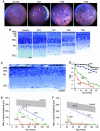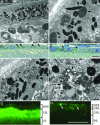Lipofuscin accumulation, abnormal electrophysiology, and photoreceptor degeneration in mutant ELOVL4 transgenic mice: a model for macular degeneration
- PMID: 15749821
- PMCID: PMC554798
- DOI: 10.1073/pnas.0407698102
Lipofuscin accumulation, abnormal electrophysiology, and photoreceptor degeneration in mutant ELOVL4 transgenic mice: a model for macular degeneration
Abstract
Macular degeneration is a heterogeneous group of disorders characterized by photoreceptor degeneration and atrophy of the retinal pigment epithelium (RPE) in the central retina. An autosomal dominant form of Stargardt macular degeneration (STGD) is caused by mutations in ELOVL4, which is predicted to encode an enzyme involved in the elongation of long-chain fatty acids. We generated transgenic mice expressing a mutant form of human ELOVL4 that causes STGD. In these mice, we show that accumulation by the RPE of undigested phagosomes and lipofuscin, including the fluorophore, 2-[2,6-dimethyl-8-(2,6,6-trimethyl-1-cyclohexen-1-yl)-1E,3E,5E,7E-octatetraenyl]-1-(2-hyydroxyethyl)-4-[4-methyl-6-(2,6,6,-trimethyl-1-cyclohexen-1-yl)-1E,3E,5E-hexatrienyl]-pyridinium (A2E) is followed by RPE atrophy. Subsequently, photoreceptor degeneration occurs in the central retina in a pattern closely resembling that of human STGD and age-related macular degeneration. The ELOVL4 transgenic mice thus provide a good model for both STGD and dry age-related macular degeneration, and represent a valuable tool for studies on therapeutic intervention in these forms of blindness.
Figures




References
-
- Bressler, N. M., Bressler, S. B. & Fine, S. L. (1988) Surv. Ophthalmol. 32, 375–413. - PubMed
-
- Friedman, D. S., O'Colmain, B. J., Munoz, B., Tomany, S. C., McCarty, C., de Jong, P. T., Nemesure, B., Mitchell, P. & Kempen, J. (2004) Arch. Ophthalmol. 122, 564–572. - PubMed
-
- Zhang, K., Kniazeva, M., Han, M., Li, W., Yu, Z., Yang, Z., Li, Y., Metzker, M. L., Allikmets, R., Zack, D. J., et al. (2001) Nat. Genet. 27, 89–93. - PubMed
-
- Edwards, A. O., Donoso, L. A. & Ritter, R., III (2001) Invest. Ophthalmol. Vis. Sci. 42, 2652–2663. - PubMed
Publication types
MeSH terms
Substances
Grants and funding
- R01EY05235/EY/NEI NIH HHS/United States
- M01-RR00064/RR/NCRR NIH HHS/United States
- R01 EY014448/EY/NEI NIH HHS/United States
- R01 EY007042/EY/NEI NIH HHS/United States
- R01EY14428/EY/NEI NIH HHS/United States
- P30 EY012598/EY/NEI NIH HHS/United States
- R01 EY014428/EY/NEI NIH HHS/United States
- R01EY14448/EY/NEI NIH HHS/United States
- M01 RR000064/RR/NCRR NIH HHS/United States
- R01 EY005235/EY/NEI NIH HHS/United States
- R01EY13408/EY/NEI NIH HHS/United States
- R01 EY013408/EY/NEI NIH HHS/United States
- P30EY12598/EY/NEI NIH HHS/United States
LinkOut - more resources
Full Text Sources
Other Literature Sources
Medical
Molecular Biology Databases

